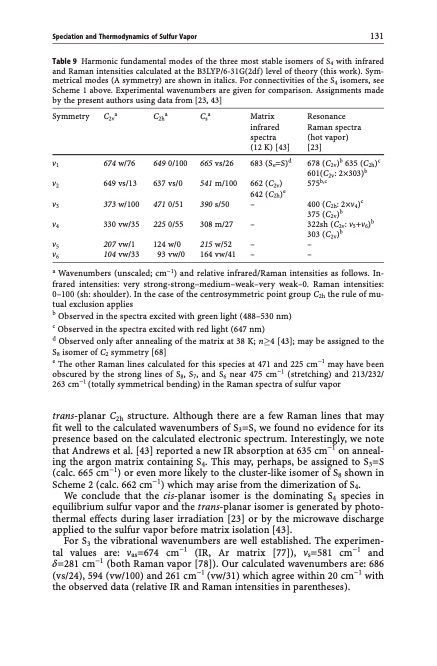
PDF Publication Title:
Text from PDF Page: 141
Speciation and Thermodynamics of Sulfur Vapor 131 Table 9 Harmonic fundamental modes of the three most stable isomers of S4 with infrared and Raman intensities calculated at the B3LYP/6-31G(2df) level of theory (this work). Sym- metrical modes (A symmetry) are shown in italics. For connectivities of the S4 isomers, see Scheme 1 above. Experimental wavenumbers are given for comparison. Assignments made by the present authors using data from [23, 43] Symmetry C2va n1 674 w/76 n2 649 vs/13 n3 373 w/100 n4 330 vw/35 n5 207 vw/1 n6 104 vw/33 C2ha 649 0/100 637 vs/0 471 0/51 225 0/55 124 w/0 93 vw/0 Csa 665 vs/26 541 m/100 390 s/50 308 m/27 215 w/52 164 vw/41 Matrix infrared spectra (12 K) [43] 683 (Sn=S)d 662 (C2v) 642 (C2h)e – – – – Resonance Raman spectra (hot vapor) [23] 678 (C2v)b 635 (C2h)c 601(C2v: 2303)b 575b,c 400 (C2h: 2n4)c 375 (C2v)b 322sh (C2v: n5+n6)b 303 (C2v)b – – a Wavenumbers (unscaled; cm1) and relative infrared/Raman intensities as follows. In- frared intensities: very strong-strong–medium–weak–very weak–0. Raman intensities: 0–100 (sh: shoulder). In the case of the centrosymmetric point group C2h the rule of mu- tual exclusion applies b Observed in the spectra excited with green light (488–530 nm) c Observed in the spectra excited with red light (647 nm) d Observed only after annealing of the matrix at 38 K; n4 [43]; may be assigned to the S8 isomer of C2 symmetry [68] e The other Raman lines calculated for this species at 471 and 225 cm1 may have been obscured by the strong lines of S8, S7, and S6 near 475 cm1 (stretching) and 213/232/ 263 cm1 (totally symmetrical bending) in the Raman spectra of sulfur vapor trans-planar C2h structure. Although there are a few Raman lines that may fit well to the calculated wavenumbers of S3=S, we found no evidence for its presence based on the calculated electronic spectrum. Interestingly, we note that Andrews et al. [43] reported a new IR absorption at 635 cm1 on anneal- ing the argon matrix containing S4. This may, perhaps, be assigned to S3=S (calc. 665 cm1) or even more likely to the cluster-like isomer of S8 shown in Scheme 2 (calc. 662 cm1) which may arise from the dimerization of S4. We conclude that the cis-planar isomer is the dominating S4 species in equilibrium sulfur vapor and the trans-planar isomer is generated by photo- thermal effects during laser irradiation [23] or by the microwave discharge applied to the sulfur vapor before matrix isolation [43]. For S3 the vibrational wavenumbers are well established. The experimen- tal values are: nas=674 cm1 (IR, Ar matrix [77]), ns=581 cm1 and d=281 cm1 (both Raman vapor [78]). Our calculated wavenumbers are: 686 (vs/24), 594 (vw/100) and 261 cm1 (vw/31) which agree within 20 cm1 with the observed data (relative IR and Raman intensities in parentheses).PDF Image | Topics in Current Chemistry

PDF Search Title:
Topics in Current ChemistryOriginal File Name Searched:
Elemental-Sulfur-und-Sulfur-Rich-Compounds-I.pdfDIY PDF Search: Google It | Yahoo | Bing
Sulfur Deposition on Carbon Nanofibers using Supercritical CO2 Sulfur Deposition on Carbon Nanofibers using Supercritical CO2. Gamma sulfur also known as mother of pearl sulfur and nacreous sulfur... More Info
CO2 Organic Rankine Cycle Experimenter Platform The supercritical CO2 phase change system is both a heat pump and organic rankine cycle which can be used for those purposes and as a supercritical extractor for advanced subcritical and supercritical extraction technology. Uses include producing nanoparticles, precious metal CO2 extraction, lithium battery recycling, and other applications... More Info
| CONTACT TEL: 608-238-6001 Email: greg@infinityturbine.com | RSS | AMP |